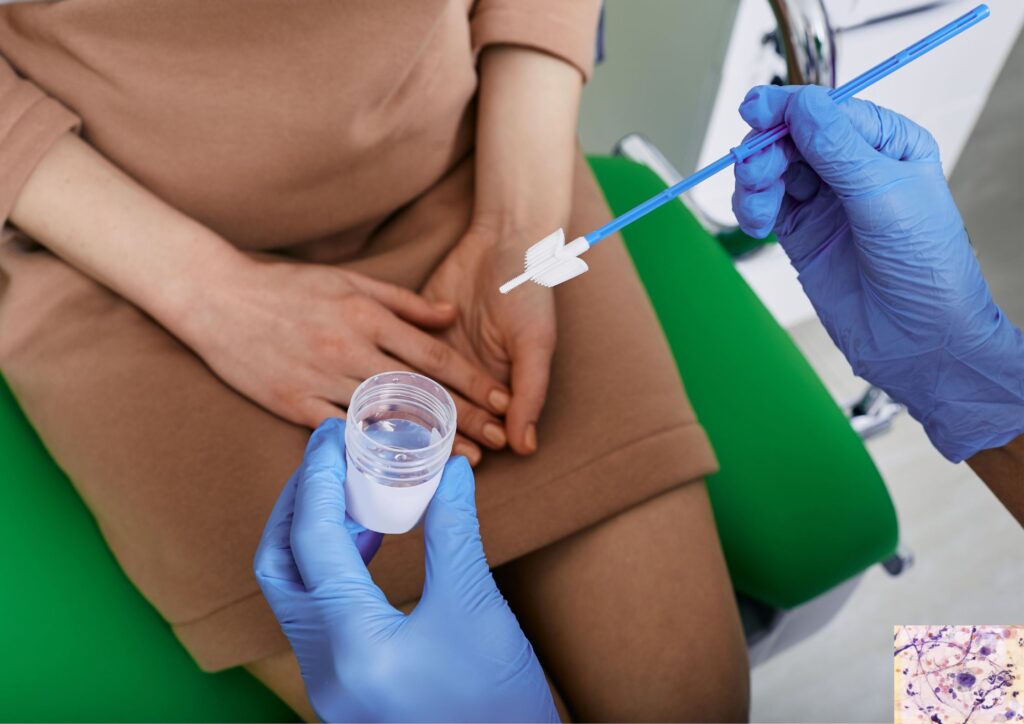For many women, the term pap smear sounds intimidating. However, this simple test is one of the most effective tools for detecting early signs of cervical health issues. Yet, myths and misunderstandings still surround the pap smear procedure, leaving many women confused or anxious.
This article dives into the facts, busts the myths, and clearly explains what a pap test is, what it detects, and how to understand your results.

So, what is pap smear testing all about? A pap smear is a screening test done to detect abnormal cells in the cervix. The cervix is the lower part of the uterus, and catching abnormal changes early can help prevent cervical cancer.
This test is named after Dr. George Papanicolaou, who developed the technique.
The pap smear test is not just a routine check; it’s a life-saving diagnostic tool A Pap smear plays a vital role in identifying early changes in cervical cells that could develop into cancer over time. Catching these changes early greatly increases the chances of effective treatment.
This screening also helps healthcare providers determine whether additional procedures—like an HPV test or a colposcopy—are necessary for a closer evaluation.
Many women feel nervous before their first pap smear procedure but knowing what to expect helps.
Here’s a quick look at the steps:
Wondering how long does a pap smear take? Most appointments are completed in less than 10 minutes, with the procedure itself taking only a couple of minutes.
You might be asking, what does a pap smear test for exactly?
The test screens for:
It’s not designed to detect STDs, but your doctor may test for those during the same visit.
Timing matters. So, pap smear how often should you get one?
According to guidelines:
If you have specific risk factors—such as a compromised immune system or previous abnormal Pap results—your doctor may recommend getting screened more often than usual.
Let’s break down a few popular myths.
Myth 1: If you’re feeling fine, there’s no need for a Pap smear.
Reality: Symptoms don’t always appear in the early stages of cervical changes. Regular pap tests are critical even if you feel fine.
Myth 2: A Pap is always painful.
Reality: While it may feel a bit uncomfortable, the smear is usually quick and tolerable.
Myth 3: Only sexually active women need it.
Reality: Cervical cancer can still develop even if you’re not currently sexually active.
Receiving your Pap smear results can feel overwhelming, especially if the terms sound unfamiliar or concerning. However, understanding what the results actually indicate can help ease anxiety and guide your next steps. Here’s a breakdown of the common categories your results may fall into:
This indicates that your cervical cells look normal, with no evidence of unusual or abnormal changes.
It’s the best possible result, and you can continue with routine screenings as recommended by your healthcare provider—usually every 3 to 5 years, depending on your age and health history.
In some cases, the Pap smear reveals minor changes in the cervical cells, but it’s not clear whether these changes are due to infection, inflammation, or early signs of something more serious. This result is often referred to as “unclear” or “ASC-US.” Your provider may recommend further testing, such as an HPV (human papillomavirus) test, to better assess the risk of cervical disease.
An abnormal result indicates that changes were found in the cervical cells. These cell changes may vary in severity, from minor (low-grade) alterations to more serious (high-grade) abnormalities.
. While this might sound alarming, it does not mean you have cancer. In many cases, abnormal cells can return to normal on their own, especially in younger women. However, your doctor may suggest follow-up tests like a colposcopy or a biopsy to determine if treatment is needed to prevent progression to cervical cancer.

Hearing the word “abnormal” can be unsettling, but it’s important to remember that early detection is key. Most cervical cell changes are treatable, especially when found early. Following your doctor’s advice and keeping up with recommended screenings ensures you stay on top of your cervical health.
If you’ve recently had a Pap smear and are unsure about your results, don’t hesitate to reach out to your healthcare provider. They can explain your specific situation and help you understand what comes next.
To get the most accurate results:
Comfortable clothing and a relaxed mindset help too.
While the pap smear checks for abnormal cells, HPV testing detects the virus that can cause these changes.
Doctors may combine both tests in what’s called co-testing, especially for women over 30. This approach gives a more complete picture of cervical health.

Routine pap smear tests can lower cervical cancer rates significantly. Before widespread screening, cervical cancer was one of the leading causes of cancer death among women. Now, it’s one of the most preventable.
That’s why following your doctor’s advice and not skipping appointments matters.
A screening test to detect abnormal cervical cells that might lead to cancer.
It checks for cell changes in the cervix, inflammation, and infections.
Every 3 years starting at age 21, unless advised otherwise by your doctor.
You risk missing early warning signs of cervical cancer, which could delay treatment.
The actual procedure takes less than 5 minutes.
Typically, you can expect to receive your Pap smear results within a timeframe of one to three weeks.
Sometimes, but not always. It depends on lab processing and urgency.
Yes, unless advised otherwise. You may feel more comfortable waiting a day.
It’s the same as a pap test—a way to collect cervical cells for analysis.
It’s a soft brush or spatula that gently collects cells without cutting or scraping.
11.What’s a Pap Smear vs. a Pap Test?
Essentially, both terms mean the same thing. If you’re wondering what’s a pap smear, it’s just another way to say pap test. Both involve the same screening process.
The pap smear may seem like a small appointment, but it has a big impact. It gives you a chance to catch problems early, avoid complications, and take charge of your well-being.
If you’re overdue for your pap smear test, now is the perfect time to schedule it. Ask questions, talk to your doctor, and stay informed.
Your body deserves this care—and so do you.
We are currently accepting new patients.

We believe in putting healthcare back where it belongs—in the hands of you and your doctor. With no insurance barriers, long waits, or rushed visits, we provide the time, attention, and quality care you deserve. Experience a better way to manage your health with Direct Primary Care of Florida.
© 2025 Direct Primary Care of Florida.